2023 TOYOTA 86 warning light
[x] Cancel search: warning lightPage 27 of 449
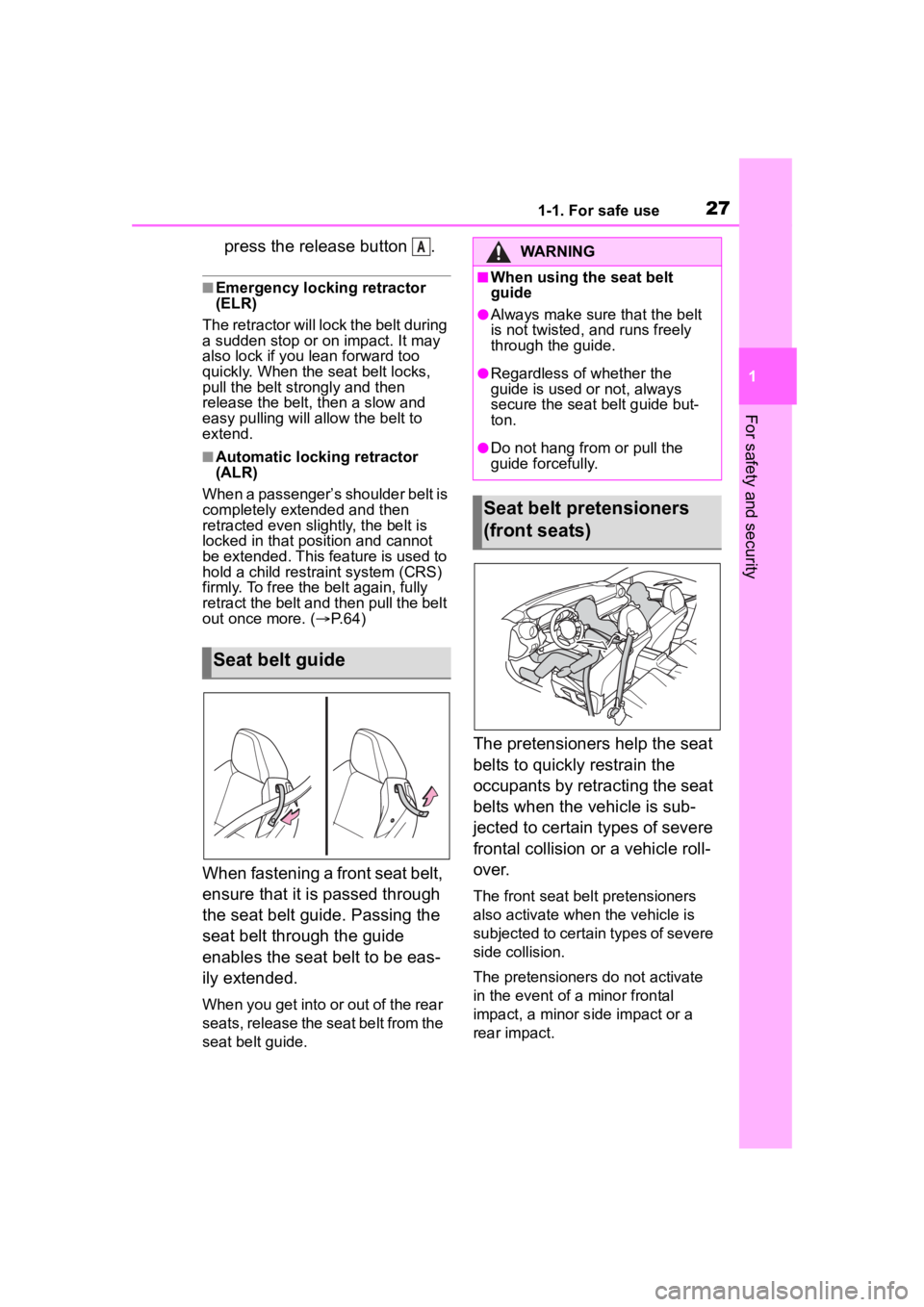
271-1. For safe use
1
For safety and security
press the release button .
■Emergency locking retractor
(ELR)
The retractor will lock the belt during
a sudden stop or on impact. It may
also lock if you lean forward too
quickly. When the seat belt locks,
pull the belt str ongly and then
release the belt, then a slow and
easy pulling will allow the belt to
extend.
■Automatic locking retractor
(ALR)
When a passenger’s shoulder belt is
completely extended and then
retracted even slightly, the belt is
locked in that position and cannot
be extended. This feature is used to
hold a child restraint system (CRS)
firmly. To free the belt again, fully
retract the belt and then pull the belt
out once more. ( P. 6 4 )
When fastening a front seat belt,
ensure that it is passed through
the seat belt guide. Passing the
seat belt through the guide
enables the seat belt to be eas-
ily extended.
When you get into or out of the rear
seats, release the seat belt from the
seat belt guide.
The pretensioners help the seat
belts to quickly restrain the
occupants by retracting the seat
belts when the vehicle is sub-
jected to certain types of severe
frontal collision or a vehicle roll-
over.
The front seat belt pretensioners
also activate when the vehicle is
subjected to certain types of severe
side collision.
The pretensioners do not activate
in the event of a minor frontal
impact, a minor s ide impact or a
rear impact.
Seat belt guide
AWARNING
■When using the seat belt
guide
●Always make sure that the belt
is not twisted, and runs freely
through the guide.
●Regardless of whether the
guide is used or not, always
secure the seat belt guide but-
ton.
●Do not hang fr om or pull the
guide forcefully.
Seat belt pretensioners
(front seats)
Page 28 of 449
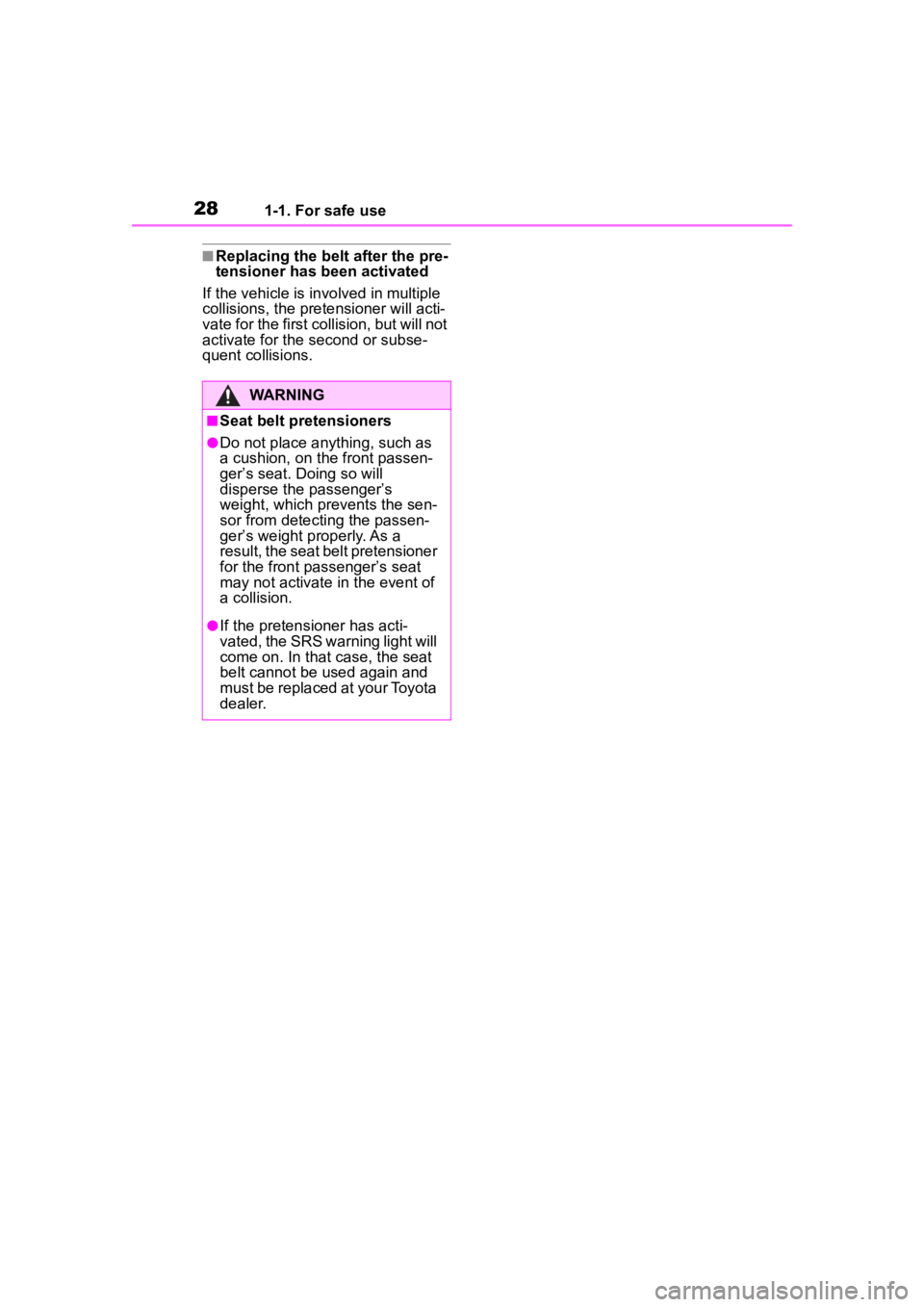
281-1. For safe use
■Replacing the belt after the pre-
tensioner has been activated
If the vehicle is in volved in multiple
collisions, the pretensioner will acti-
vate for the first collision, but will not
activate for the second or subse-
quent collisions.
WARNING
■Seat belt pretensioners
●Do not place anything, such as
a cushion, on the front passen-
ger’s seat. Doing so will
disperse the passenger’s
weight, which prevents the sen-
sor from detecting the passen-
ger’s weight properly. As a
result, the seat belt pretensioner
for the front passenger’s seat
may not activate in the event of
a collision.
●If the pretensioner has acti-
vated, the SRS warning light will
come on. In that case, the seat
belt cannot be used again and
must be replaced at your Toyota
dealer.
Page 31 of 449

311-1. For safe use
1
For safety and security
■SRS airbag system componentsFront impact sensor (left-hand side)
Front impact sensor (right-hand side)
SRS warning light
Frontal airbag module (driver’s side)
Airbag control module (including impact sensor and rollover sen-
sor)
Front passenger’s frontal airbag ON and OFF indicator
Frontal airbag module (front passenger’s side)
Seatbelt buckle switch (front passenger’s side)
Curtain shield airbag module (right-hand side)
Side impact sensor (door right-hand side)
Side airbag module (fr ont passenger’s side)
Seatbelt pretensioner and adaptive force limiter (front passen-
ger’s side)
Side impact sensor (center pillar right-hand side)
Airbag wiring
Side impact sensor (rear wheel house right-hand side)
Front passenger’s occupant detection system sensor
A
C
D
Page 36 of 449
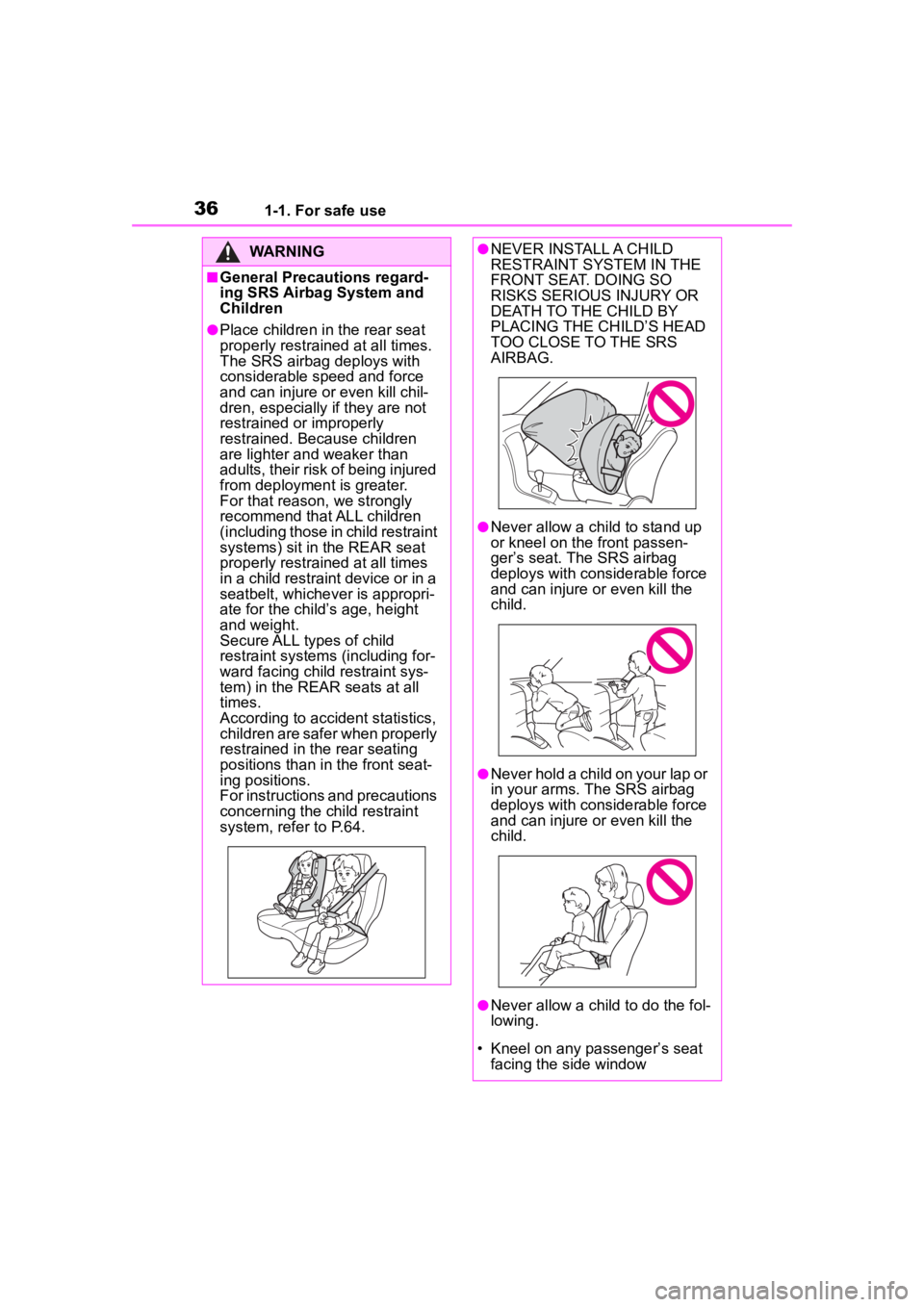
361-1. For safe use
WARNING
■General Precautions regard-
ing SRS Airbag System and
Children
●Place children in the rear seat
properly restrained at all times.
The SRS airbag deploys with
considerable speed and force
and can injure or even kill chil-
dren, especially if they are not
restrained or improperly
restrained. Because children
are lighter and weaker than
adults, their risk of being injured
from deployment is greater.
For that reason, we strongly
recommend that ALL children
(including those in child restraint
systems) sit in the REAR seat
properly restrained at all times
in a child restraint device or in a
seatbelt, whichever is appropri-
ate for the child’s age, height
and weight.
Secure ALL types of child
restraint systems (including for-
ward facing child restraint sys-
tem) in the REAR seats at all
times.
According to accident statistics,
children are safer when properly
restrained in the rear seating
positions than in the front seat-
ing positions.
For instructions and precautions
concerning the child restraint
system, refer to P.64.
●NEVER INSTALL A CHILD
RESTRAINT SYSTEM IN THE
FRONT SEAT. DOING SO
RISKS SERIOUS INJURY OR
DEATH TO THE CHILD BY
PLACING THE CHILD’S HEAD
TOO CLOSE TO THE SRS
AIRBAG.
●Never allow a child to stand up
or kneel on the front passen-
ger’s seat. The SRS airbag
deploys with considerable force
and can injure o r even kill the
child.
●Never hold a child on your lap or
in your arms. The SRS airbag
deploys with considerable force
and can injure o r even kill the
child.
●Never allow a child to do the fol-
lowing.
• Kneel on any passenger’s seat facing the side window
Page 46 of 449

461-1. For safe use
■If the passenger’s frontal airbag
OFF indicator illuminates and
the ON indicator turns off even
when the front passenger’s seat
is occupied by an adult
This can be caused by the adult
incorrectly sitting in the front pas-
senger’s seat.
1 Turn the engine switch off.
2 Ask the front passenger to set
the seatback to the upright posi-
tion, sit up straight in the center
of the seat cushion, correctly fas-
ten the seatbelt, position his/her
legs out forward, and adjust the
seat to the rearmost position.
3 Turn the engine switch to ON.
If the OFF indicator remains illumi-
nated while the ON indicator
remains off, take the following
actions.
1 Turn the engine switch off.
2 Make sure that the front passen-
ger does not use a blanket, extra
seat cushion, sea t cover, extra
seat heater or massager, etc.
3 If wearing excessive layers of
clothing, the front passenger
should remove any unnecessary
items before sitting in the front
passenger’s seat, or should sit in
a rear seat.
4 Turn the engine switch to ON
and wait 6 seconds to allow the
system to complete self-check-
ing. Following the system check,
both indicators turn off for 2 sec-
onds. Now, the ON indicator
should illuminate while the OFF
indicator remains off.
If the OFF indicator still remains illu-
minated while the ON indicator
remains off, ask the occupant to
move to the rear seat and immedi-
ately contact your Toyota dealer for
an inspection.■If the seatbelt buckle switch
and/or front passenger’s occu-
pant detection system have
failed
If the seatbelt buckle switch and/or
front passenger’s occupant detec-
tion system have failed, the SRS
warning light will illuminate. Have
the system inspected by your Toyota
dealer immediately if the SRS warn-
ing light illuminates.
■When to contact your Toyota
dealer
If your vehicle has sustained impact,
this may affect the proper function of
the Toyota advanced frontal airbag
system. Have your vehicle
inspected at your Toyota dealer. Do
not use the front passenger’s seat
while driving the vehicle to your Toy-
ota dealer.
WARNING
■When using a child restraint
system
NEVER INSTALL A CHILD
RESTRAINT SYSTEM IN THE
FRONT PASSENGER’S SEAT
EVEN IF THE FRONT PASSEN-
GER’S SRS FRONTAL AIRBAG
IS DEACTIVATED. Be sure to
install it in the REAR seat in a cor-
rect manner. Also, it is strongly
recommended that any forward
facing child seat or booster seat
be installed in the REAR seat, and
that even children who have out-
grown a child restraint system be
also seated in the REAR seat.
This is because children sitting in
the front passenger’s seat may be
killed or severely injured should
the front passenger’s SRS frontal
airbag deploy. REAR seats are
the safest place for children.
Page 47 of 449
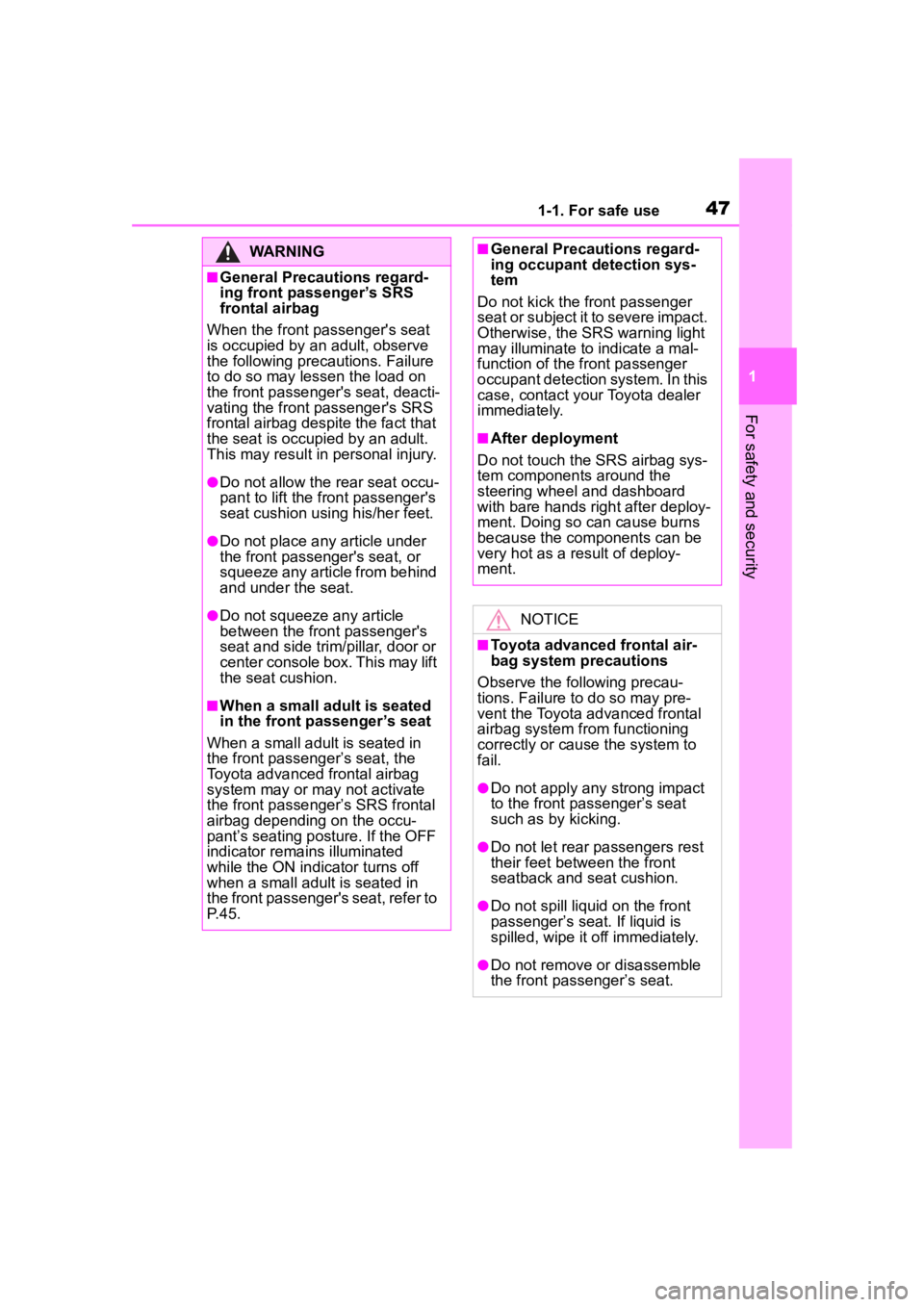
471-1. For safe use
1
For safety and security
WARNING
■General Precautions regard-
ing front passenger’s SRS
frontal airbag
When the front passenger's seat
is occupied by an adult, observe
the following precautions. Failure
to do so may lessen the load on
the front passenger 's seat, deacti-
vating the front passenger's SRS
frontal airbag despite the fact that
the seat is occupied by an adult.
This may result in personal injury.
●Do not allow the rear seat occu-
pant to lift the front passenger's
seat cushion using his/her feet.
●Do not place any article under
the front passenger's seat, or
squeeze any article from behind
and under the seat.
●Do not squeeze any article
between the front passenger's
seat and side trim/pillar, door or
center console box. This may lift
the seat cushion.
■When a small a dult is seated
in the front passenger’s seat
When a small adult is seated in
the front passeng er’s seat, the
Toyota advanced frontal airbag
system may or may not activate
the front passenger’s SRS frontal
airbag depending on the occu-
pant’s seating posture. If the OFF
indicator remains illuminated
while the ON indi cator turns off
when a small adult is seated in
the front passenger's seat, refer to
P. 4 5 .
■General Precautions regard-
ing occupant detection sys-
tem
Do not kick the front passenger
seat or subject it to severe impact.
Otherwise, the SRS warning light
may illuminate to indicate a mal-
function of the front passenger
occupant detection system. In this
case, contact your Toyota dealer
immediately.
■After deployment
Do not touch the SRS airbag sys-
tem components around the
steering wheel and dashboard
with bare hands right after deploy-
ment. Doing so can cause burns
because the components can be
very hot as a result of deploy-
ment.
NOTICE
■Toyota advanced frontal air-
bag system precautions
Observe the following precau-
tions. Failure to do so may pre-
vent the Toyota advanced frontal
airbag system from functioning
correctly or cause the system to
fail.
●Do not apply any strong impact
to the front passenger’s seat
such as by kicking.
●Do not let rear passengers rest
their feet between the front
seatback and seat cushion.
●Do not spill liquid on the front
passenger’s seat. If liquid is
spilled, wipe it o ff immediately.
●Do not remove or disassemble
the front passenger’s seat.
Page 54 of 449
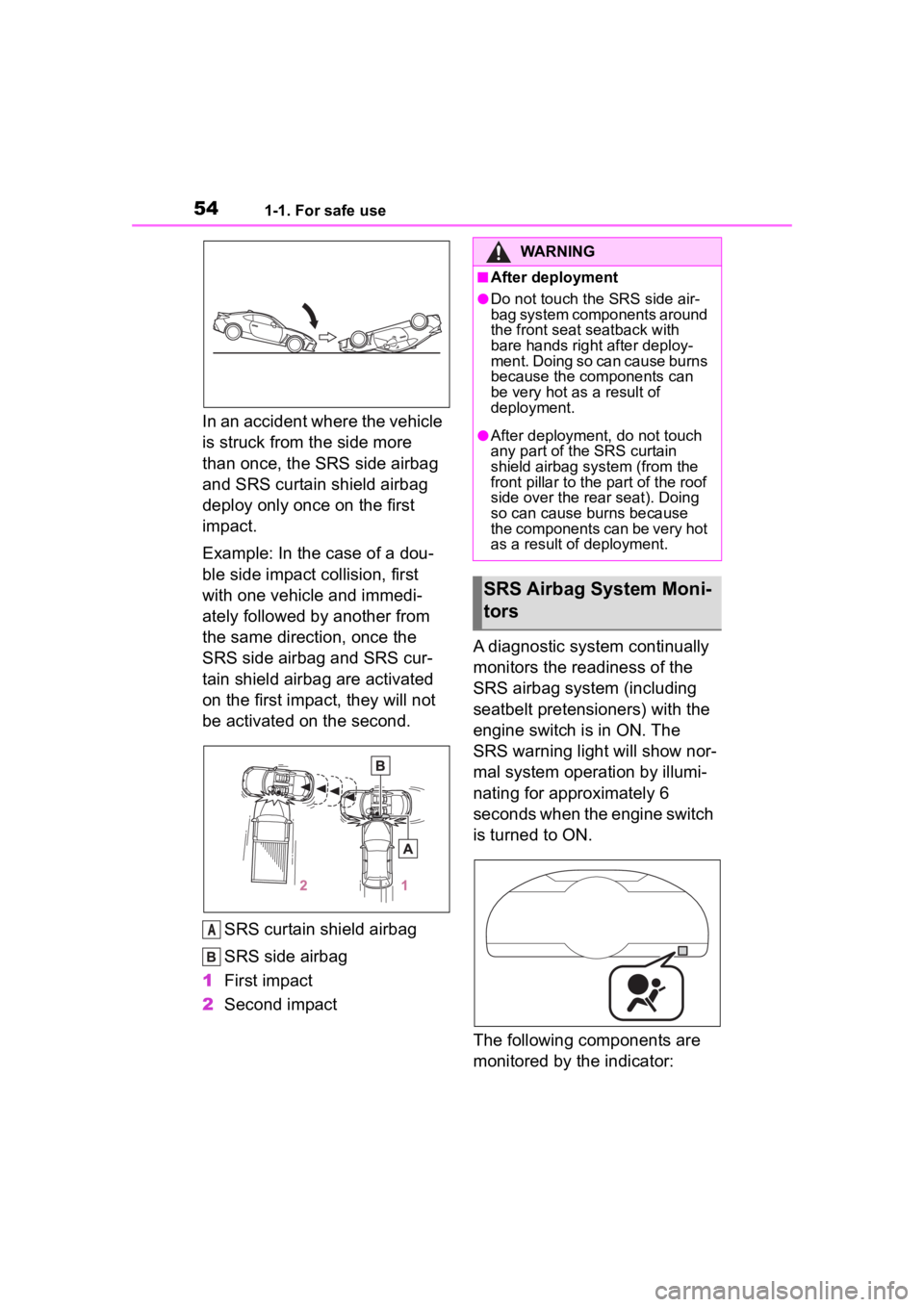
541-1. For safe use
In an accident where the vehicle
is struck from the side more
than once, the SRS side airbag
and SRS curtain shield airbag
deploy only once on the first
impact.
Example: In the case of a dou-
ble side impact collision, first
with one vehicle and immedi-
ately followed by another from
the same direction, once the
SRS side airbag and SRS cur-
tain shield airbag are activated
on the first impact, they will not
be activated on the second.SRS curtain shield airbag
SRS side airbag
1 First impact
2 Second impact A diagnostic system continually
monitors the readiness of the
SRS airbag system (including
seatbelt pretensioners) with the
engine switch is in ON. The
SRS warning light will show nor-
mal system operation by illumi-
nating for approximately 6
seconds when the engine switch
is turned to ON.
The following components are
monitored by the indicator:
A
WARNING
■After deployment
●Do not touch the SRS side air-
bag system components around
the front seat seatback with
bare hands right after deploy-
ment. Doing so can cause burns
because the components can
be very hot as a result of
deployment.
●After deployment
, do not touch
any part of the SRS curtain
shield airbag sys tem (from the
front pillar to the part of the roof
side over the rear seat). Doing
so can cause burns because
the components can be very hot
as a result of deployment.
SRS Airbag System Moni-
tors
Page 55 of 449

551-1. For safe use
1
For safety and security
Front impact sensor
• Right-hand side
• Left-hand side
Airbag control module (includ-
ing impact sensor and rollover
sensor)
Frontal airbag module
• Driver’s side
• Front passenger’s side
Knee airbag module
• Driver’s side
Side impact sensor
• Center pillar left-hand side
• Center pillar right-hand side
• Forward of rear wheel house
left-hand side
• Forward of rear wheel house right-hand side
• Door left-hand side
• Door right-hand side
Side airbag module
• Driver’s side
• Front passenger’s side
Curtain shield airbag module
• Right-hand side
• Left-hand side
Seatbelt pretensioner
• Driver’s side
Seatbelt pretensioner and
adaptive force limiter
• Front passenger’s side
Seatbelt buckle switch
• Front passenger’s side
Front passenger’s occupant detection system sensors
Front passenger’s frontal air-
bag ON and OFF indicator
All related wiring
■SRS warning light
Have the system inspected by your
Toyota dealer i mmediately if the
SRS warning light illuminates.
WARNING
■SRS warning light
If the warning light exhibits any of
the following conditions, immedi-
ately stop the vehicle in a safe
place, and consult a Toyota
dealer. Unless a technician
checks and repairs the system as
needed, the seatbelt pretension-
ers and/or the SRS airbag may
not operate properl y in the event
of a collision, which may result in
injury.
●Flashing or flickering of the
warning light
●No illumination of the warning
light when the engine switch is
first turned to ON
●Continuous illumination of the
warning light
●Illumination of the warning light
while driving